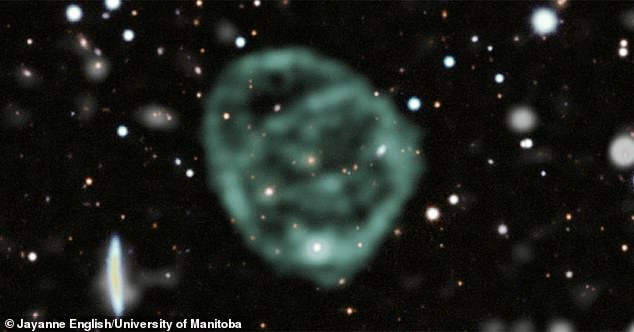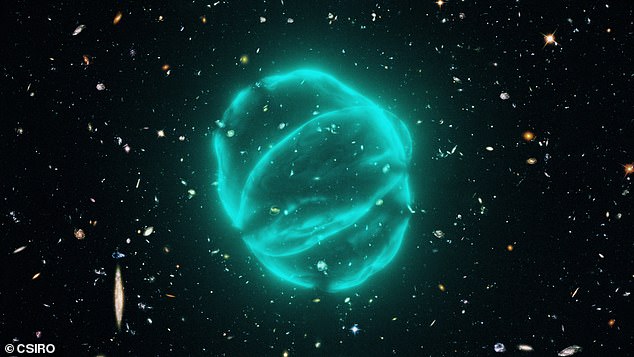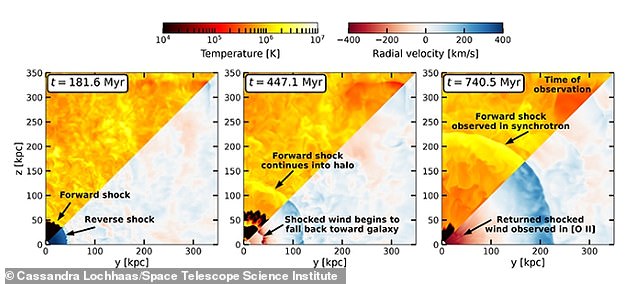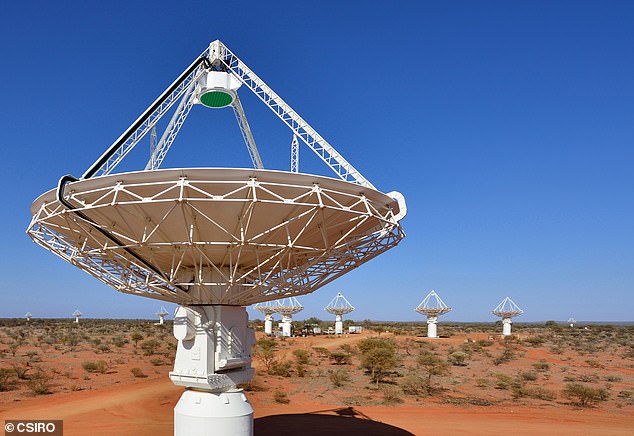Scientists discover the origin of the universe's mysterious radio circles that appear in the depths of space
Astronomers may have solved the mystery of giant circles of radio waves first observed in 2019 floating in the depths of space.
A team at the University of California San Diego discovered that strange radio circles (ORCs) are formed by outflowing winds caused by explosive events such as a supernova.
Astronomers have found that when enough massive stars die and explode close to each other, the force pushes the surrounding gas outward, creating outflowing winds traveling at speeds of more than 2,000 kilometers per second.
The enormous force of the outflowing wind forms the shells that make up the radio wave circles, which can be more than 50,000 times the diameter of our Milky Way.

Astronomers may have solved the long-held mystery of giant circles of radio waves that appear blurry as they float in the depths of space
Astrophysicist Alison Coil said: 'These galaxies are really interesting. They are formed when two large galaxies collide.
'The merger pushes all the gas into a very small area, causing an intense burst of star formation.
“Heavy stars burn up quickly, and when they die they expel their gas as outflowing winds.”
To unravel the mystery, the team simulated outflowing galactic winds Blowing for 200 million years before it switches off.
When the wind stops, a forward-moving shock pushed high-temperature gas out of the galaxy and created a radio ring.
And then a reverse shock sent cooler gas flowing back into the Milky Way.


A team from the University of California San Diego discovered that strange radio circles (ORCs) are formed by outflowing winds caused by explosive events such as a supernova
The simulation is designed to take place over the course of 750 million years, which the team says is approximately the estimated age of an ORC observed by astronomers in the past.
Astronomers discovered the radio wave circles in 2019 using the Australian Square Kilometer Array Pathfinder (ASKAP), but they were stunned by what they discovered.
It was such an unusual discovery that Coil and her team set out to find out how and why it came about.
Before the ASKAP telescope, astronomers had only observed ORCs through radio emissions, but had no access to visual data.
It led to several theories about the origins of the phenomenon, including planetary nebulae, when cosmic gas and dust are ejected from the outer layers of a dying star and black hole mergers.
The latter emits gravitational radiation when two black holes merge.
Both theories were rejected and replaced with the possibility that starburst galaxies created the ORCs.
Coil and her team used optical and infrared image data to determine that the stars in the ORC 4 galaxy were six billion years old.


Alison Coil and her team discovered that the force of outward winds from huge exploding stars created the ORCs


Astronomers used the ASKAP to capture images of ORCs that previously could only be viewed via radio emissions
“There was a burst of star formation in this galaxy,” Coil said, “but that ended about a billion years ago.
'It turns out that the galaxies we studied have such high mass outflow rates. They are rare, but they do exist.
“I really think this indicates that ORCs come from some kind of outflowing galactic winds.”
The ASKAP is the world's fastest telescope, consisting of 36 antennas each with a diameter of 12 centimeters, and is designed to detect hundreds more galaxies than its predecessors to understand how galaxies form and evolve, including how the galaxy of the earth developed.
The telescope scans large areas of the sky for faint boundaries, allowing astronomers to see the ORCs stretching for hundreds of kiloparsecs – equivalent to 3,260 light-years.
Coil said that 'ORCs give us a way to 'see' the wind through radio data and spectroscopy.'
This means they can further determine how often the outflowing galactic winds occur and how long the wind's life cycle lasts, and will help astronomers learn more about the evolution of galaxies.
'Do all massive galaxies go through an ORC phase? Do spiral galaxies become elliptical when they stop forming stars?' Coil wondered, adding, “I think we can learn a lot about ORCs and from ORCs.”
